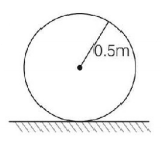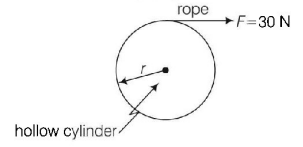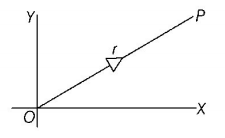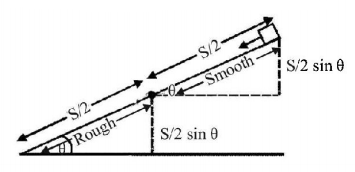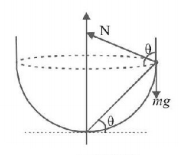1. A bridge is in the from of a semi-circle of radius $$40\,m.$$ The greatest speed with which a motor cycle can cross the bridge without leaving the ground at the highest point is $$\left( {g = 10\,m{s^{ - 2}}} \right)$$ (frictional force is negligibly smatt)
A.
$$40\,m{s^{ - 1}}$$
B.
$$20\,m{s^{ - 1}}$$
C.
$$30\,m{s^{ - 1}}$$
D.
$$15\,m{s^{ - 1}}$$
Answer :
$$20\,m{s^{ - 1}}$$
2. A uniform circular disc of radius $$50\,cm$$ at rest is free to turn about an axis which is perpendicular to its plane and passes through its centre. It is subjected to a torque which produces a constant angular acceleration of $$2.0\,rad\,{s^{ - 2}}.$$ Its net acceleration in $$m{s^{ - 2}}$$ at the end of $$2.0\,s$$ is a approximately
A.
7.0
B.
6.0
C.
3.0
D.
8.0
Answer :
8.0
3. One end of string of length $$l$$ is connected to a particle of mass $$'m'$$ and the other end is connected to a small peg on a smooth horizontal table. If the particle moves in circle with speed $$'v'$$ the net force on the particle (directed towards centre) will be ($$T$$ represents the tension in the string) :-
A.
$$T + \frac{{m{v^2}}}{l}$$
B.
$$T - \frac{{m{v^2}}}{l}$$
C.
Zero
D.
$$T$$
Answer :
$$T$$
4. A car of mass $$1000\,kg$$ negotiates a banked curve of radius $$90\,m$$ on a frictionless road. If the banking angle is $${45^ \circ },$$ the speed of the car is
A.
$$20\,m{s^{ - 1}}$$
B.
$$30\,m{s^{ - 1}}$$
C.
$$5\,m{s^{ - 1}}$$
D.
$$10\,m{s^{ - 1}}$$
Answer :
$$30\,m{s^{ - 1}}$$
5. A car is negotiating a curved road of radius $$R.$$ The road is banked at an angle $$\theta .$$ the coefficient of friction between the tyres of the car and the road is $${\mu _s}.$$ The maximum safe velocity on this road is:
A.
$$\sqrt {g{R^2}\frac{{{\mu _s} + \tan \theta }}{{1 - {\mu _s}\tan \theta }}} $$
B.
$$\sqrt {gR\frac{{{\mu _s} + \tan \theta }}{{1 - {\mu _s}\tan \theta }}} $$
C.
$$\sqrt {\frac{g}{R}\frac{{{\mu _s} + \tan \theta }}{{1 - {\mu _2}\tan \theta }}} $$
D.
$$\sqrt {\frac{g}{{{R^2}}}\frac{{{\mu _s} + \tan \theta }}{{1 - {\mu _s}\tan \theta }}} $$
Answer :
$$\sqrt {gR\frac{{{\mu _s} + \tan \theta }}{{1 - {\mu _s}\tan \theta }}} $$
6. A rope is wound around a hollow cylinder of mass $$3\,kg$$ and radius $$40\,cm.$$ What is the angular acceleration of the cylinder, if the rope is pulled with a force of $$30\,N$$ ?
A.
$$25\,m/{s^2}$$
B.
$$0.25\,rad/{s^2}$$
C.
$$25\,rad/{s^2}$$
D.
$$5\,m/{s^2}$$
Answer :
$$25\,rad/{s^2}$$
7.
A particle moves so that its position vector is given by $$r = \cos \omega t\hat x + \sin \omega t\hat y,$$ where $$\omega $$ is a constant.
Which of the following is true?
A.
Velocity and acceleration both are parallel to $$r.$$
B.
Velocity is perpendicular to $$r$$ and acceleration is directed towards to origin
C.
Velocity is perpendicular to $$r$$ and acceleration is directed away form the origin
D.
Velocity and acceleration both are perpendicular to $$r.$$
Answer :
Velocity is perpendicular to $$r$$ and acceleration is directed towards to origin
8. The upper half of an inclined plane of inclination $$\theta $$ is perfectly smooth while tower half is rough. A block starting from rest at the top of the plane will again come to rest at the bottom, if the coefficient of friction between the block and lower half of the plane is given by
A.
$$\mu = \frac{2}{{\tan \theta }}$$
B.
$$\mu = 2\tan \theta $$
C.
$$\mu = \tan \theta $$
D.
$$\mu = \frac{1}{{\tan \theta }}$$
Answer :
$$\mu = 2\tan \theta $$
9.
In the given figure, a smooth parabolic wire track lies in the $$xy$$ -plane (vertical). The shape of track is defined by the equation $$y = {x^2}.$$ A ring of mass $$m$$ which can slide freely on the wire track, is placed at the position $$A\left( {1,1} \right).$$ The track is rotated with constant angular speed $$\omega $$ such there is no relative slipping between the ring and the track. The value of $$\omega $$ is
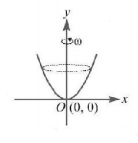
A.
$$\sqrt {\frac{g}{2}} $$
B.
$$\sqrt g $$
C.
$$\sqrt {2g} $$
D.
$$2\sqrt g $$
Answer :
$$\sqrt {2g} $$
10. A car is moving in a circular horizontal track of radius $$10\,m$$ with a constant speed of $$10\,m/s,$$ A bob is suspended from the roof of the car by a light wire of length $$1.0\,m.$$ The angle made by the wire with the vertical is
A.
$${0^ \circ }$$
B.
$$\frac{\pi }{3}$$
C.
$$\frac{\pi }{6}$$
D.
$$\frac{\pi }{4}$$
Answer :
$$\frac{\pi }{4}$$
